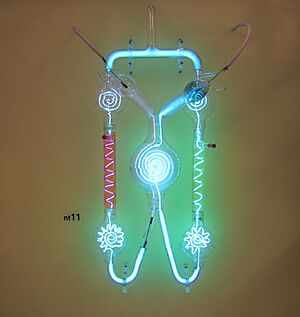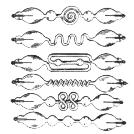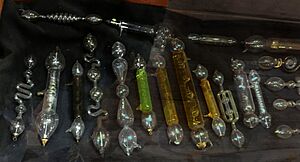Geissler tube facts for kids
A Geissler tube is an old type of gas discharge tube. It helped scientists understand how electricity makes gases glow. Think of it like an early version of today's neon lights. It was also very important for discovering the electron.
This device was created in 1857 by Heinrich Geissler. He was a German scientist and also skilled at blowing glass.
A Geissler tube is a sealed glass tube, often in cool shapes. Most of the air is sucked out of it. It has a metal part called an electrode at each end. Inside, there's a small amount of gas, like neon, argon, or even air. Sometimes, it has mercury vapor or other materials that can conduct electricity, like sodium.
When a lot of electricity (a high voltage) is sent through the tube, the gas inside lights up. This happens because the electricity makes the gas particles (molecules) lose some of their electrons. These free electrons then join back with other particles. When they do, the particles release energy as light. The color of the light depends on the type of gas inside the tube.
Around the year 1900, many colorful and artistic Geissler tubes were made. They showed off the exciting new technology of electricity. Simple, straight tubes were also used in science experiments to detect high voltage. The technology from Geissler tubes later led to commercial neon lighting around 1910, which you can still see today.
Contents
How Geissler Tubes Were Used
From the 1880s, Geissler tubes were made for fun and entertainment. They came in many shapes, with round chambers and twisty glass paths. Some tubes were very fancy, with chambers inside other glass casings.
You could get a cool effect by spinning a glowing tube very fast with a motor. It would look like a solid disk of color because of how our eyes see things (persistence of vision). If you touched a glowing tube, the light inside often changed shape. This happened because of the electricity in your body.
Geissler Tubes in Science
Simple, straight Geissler tubes were used in early science. They helped scientists detect high voltage. If you brought a Geissler tube near a strong source of electricity, like a Tesla coil, it would light up. It didn't even need to touch the electrical circuit.
Scientists used them to tune radio transmitters. They also helped find special points (called nodes) on transmission lines. These lines were used to measure the frequency of early radio signals. Around 1900, Geissler tubes were also used as light sources in special tools called refractometers. Today, Geissler tubes are sometimes still used in physics classes. They help students learn about how gas discharge tubes work.
How Geissler Tubes Changed the World
Geissler tubes were the very first gas discharge tubes. They had a huge impact on many inventions. These inventions rely on electricity flowing through gases.
One of the biggest results of Geissler tube technology was the discovery of the electron. It also led to the invention of electronic vacuum tubes. By the 1870s, scientists had better vacuum pumps. They could suck even more air out of Geissler tubes. These improved tubes were called Crookes tubes. They were named after William Crookes.
When electricity was sent through a Crookes tube, the glass at one end would glow. Johann Hittorf noticed that objects inside the tube made sharp shadows on the glowing glass. He realized that some kind of "ray" was traveling in straight lines from one end of the tube. These were called cathode rays.
In 1897, J. J. Thomson showed that cathode rays were made of a tiny, unknown particle. This particle was named the electron. Learning how to control these electron beams led to the invention of the amplifying vacuum tube in 1907. This invention created the field of electronics. It was very important for 50 years. The cathode ray tube also came from this research. It was used in radar and early television screens.
Inventions from Geissler Tube Technology
Many devices developed from the ideas first seen in Geissler tubes:
- Vacuum tubes
- Xenon flash lamps (used in cameras for flash photography)
- Xenon arc lamps (used in movie and IMAX projectors)
- X-ray tubes (used in hospitals)
- Sodium vapor lamps (used in streetlights)
- "Neon" signs (which use glowing gases and special coatings)
- Mercury vapor lamps
- Mass spectrometers (tools for studying tiny particles)
- Cathode ray tubes (used in oscilloscopes and old television sets)
- Electrotachyscope (an early device for showing moving pictures)
- Fluorescent lamps
- Plasma globes (those cool glass balls with lightning inside)
See also
- William Crookes
- Cathode ray tube
- Crookes tube
- Induction coil
- Neon sign
- Plasma globe
- X-ray tube
- German inventions and discoveries






